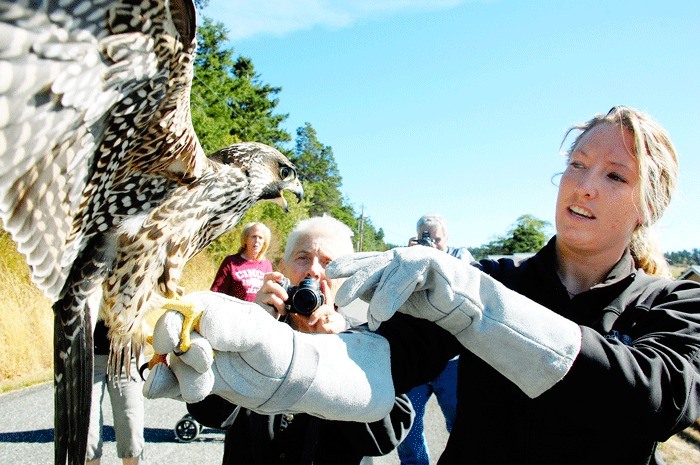Even for the fastest animal on Earth, the road to recovery can sometimes take longer than expected.
Veterinarians from Wildlife Care Clinic in Oak Harbor have been caring for an injured peregrine falcon for nearly two weeks and attempted to release it back into the wild Thursday afternoon. But at the moment of truth, when onlookers were expecting to watch it take off and soar over the horizon, the bird of prey made it clear it needs a little more R&R by refusing to take to the air.
Although clinic vets were hoping for a different result, they were only too happy to oblige. Scooping up the falcon as it hopped around on the ground, the vets returned the bird to the rescue shelter in Oak Harbor for another seven days of recovery.
“Maybe one more week and we’ll be back out to give it another try,” said Crystal Brazle, a veterinarian with Best Friends Veterinary Center.
The wildlife clinic is housed in the same building as the veterinary center but is an autonomous nonprofit dedicated to caring for sick, injured and abandoned wildlife. Staff from the veterinary center donate their time to care for the injured animals brought in, which range from common rabbits to rare raptors like the peregrine.
This particular peregrine was found about two weeks ago on Waterloo Road by residents Tami and Charles Barber. They had just left their house on their way into town when they spotted it lying in the street. It was obvious something was wrong and they just didn’t have the heart to pass it by.
“It had eyes that would look into your soul; it was so beautiful,” Tami said.
Once at the clinic, Brazle found a deep laceration on its left wing. Although it had no broken bones, one of its muscles was so badly torn that it had to be surgically removed. It’s believed the injury was the result of a collision with a wire or fence during flight.
Peregrines can reach speeds that exceed 200 mph while diving, which makes them the fastest animals in the world, Brazle said. They are located in regions across the globe, and were once commonly known throughout North America as the duck hawk, largely because waterfowl make up a large part of their diet.
While they are known to migrate as far south as Chile in South America, it’s believed some do take up a more permanent residence. Peregrines have been living in nests perched on building ledges in Seattle since the 1990s.
The Barbers said they have seen the bird regularly with what they believe is its mate. Brazle said she couldn’t be sure, but that it’s possible they are permanent residents. One of the difficulties is that they are still rather unusual on Whidbey.
Peregrines have been an endangered species for decades, according to Eric Anderson, president of the wildlife clinic and director of the veterinary center. Their numbers were decimated by the use of agricultural pesticides, such as DDT, in the 1960s. Since the products were banned in the 1970s, numbers have increased but Anderson said he’s still only had three come through his doors in 30 years of business.
Although well qualified to treat the wounded falcon, Anderson and Brazle are not peregrine specialists and there are some things they just don’t know. For example, the birds are sexually dimorphic, which means sex can only be determined by things like appearance or behavior. They were also unsure of its age.
David Parent, a South Whidbey veterinarian experienced in raptor rehabilitation, saw a picture of the bird and identified it as a member of the North Pacific Peale’s subspecies of peregrine falcon. He also couldn’t determine sex but believes it to be a juvenile, hatched sometime this summer.
Parent said most peregrines on the island are seasonal and follow the waterfowl migrations. They can typically be found at locations such as Crockett Lake on Central Whidbey. Another pair is believed to live on the cliffs near Deception Pass. At most, Parent estimated no more than 15 individuals on Whidbey at a time.
Since the bird was brought in nearly two weeks ago, Brazle said they have been working to repair surrounding tissue damage with a therapy laser. It works by promoting rapid healing.
The treatment appeared to be working well, as the raptor demonstrated a healthy appetite and even flew very short distances within its enclosure. Brazle said the behavior was enough to warrant an attempt at release.
The bird’s inability, or unwillingness, to take off may have been due to several reasons. While some bystanders joked that it had grown to like all the free meals at the clinic, Brazle said it may have been that the limb was still too sore for flight or that it just needs additional time to adjust to the loss of an entire muscle.
Whatever the case, she’s optimistic of a full recovery.
“If a one-legged man can climb Everest …” Brazle said.
She credited the Barbers with saving the animals life and a speedy return to the skies.



